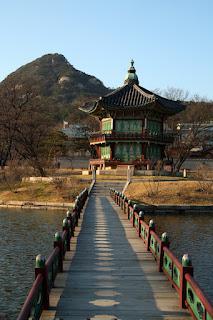First dose: Gyeongbokgung
Gyeongbok means "the new dynasty will be greatly blessed and prosperous" and gung means "palace". This greatly blessed palace was built in 1395 and served as the main palace of the Joseon dynasty for over 500 years. Over the years, the palace went thru countless fires and destruction and has been undergoing restoration since 1990.
Not to be missed at Gyeongbokgung is the changing of guards ceremony which occurs every hour from 10AM to 3PM. During the Joseon period, palace gate guards followed a strict procedure in opening/closing gates and in changing of shifts for the safety of the royal family living in the palace.
 Changing of guards at Gwanghwamun Gate (main gate)
Changing of guards at Gwanghwamun Gate (main gate)
 Different uniforms for different roles. Here are some that I have taken a photo of.From left to right: Gapsa (regular guard), Daejol (guard of palace gates),Chwitagun (member of the royal military band)
Different uniforms for different roles. Here are some that I have taken a photo of.From left to right: Gapsa (regular guard), Daejol (guard of palace gates),Chwitagun (member of the royal military band)The main throne hall of the palace called Geunjeongjeon, which means "all affairs will be properly managed if Your Majesty demonstrates diligence", is where the king held meetings, receptions, and coronation ceremonies. It looks like it has two floors but is actually just one story. There are three footpaths leading to Geunjeongjeon and only the king may walk on the center path. The stone markers on each side indicates the ranks of court officials, where they sat during meetings.
 Geunjeongjeon, the main throne hall of the palace(Photo by Bee Chavez)
Geunjeongjeon, the main throne hall of the palace(Photo by Bee Chavez)Palace buildings have structures in the shape of animals on their roof ridges to ward off evil and misfortune. The number of these animals should always be odd and not to exceed 11, depending on the importance of the building.
 Shoo away evil and bad luck!
Shoo away evil and bad luck!Two of the pavilions found in Gyeongbokgung are Hyangwonjeong pavilion and Gyeonghoeru pavilion. Gyeonghoeru is where the king had formal banquets.
 Hyangwonjeong pavilion
Hyangwonjeong pavilion Gyeonghoeru pavilion
Gyeonghoeru pavilionGyeongbokgung has two areas filled with jars. These jars store sauces and its size indicates its contents: biggest jars for soy sauce, medium ones for salted fish, and small ones for soybean paste. The place where these jars are stored is called Janggo.
 Do you really need so much sauce?
Do you really need so much sauce?The palace grounds is huge and these are just a few of the things you will see in Gyeongbokgung. Before saying goodbye to this palace, stop by Sujeongjeon, located just south of Gyeonghoeru pavilion, and try on a hanbok (traditional korean clothing). This is available from 10AM to 430PM (until 4PM only from November to February) on a first come first served basis. Each one is allowed 5 minutes to wear the hanbok.
 Koreans for just 5 minutes
Koreans for just 5 minutesTip: To fully appreciate the palace, grab a guidebook or an audio guide before exploring. Or better yet, join a guided tour. If you don't, you'll find Gyeongbokgung a snooze fest since the structures look so much alike. And if you plan to go on a palace overdose (yes, there are more: Changdeokgung palace, Huwon or Secret Garden, Changgyeonggung palace, Deoksugung palace, Jongmyo shrine), buy the integrated ticket for 10,000 won (valid for 1 month after date of purchase).
GyeongbokgungFind your way: Take the subway to Gyeongbokgung Station (line 3/orange) and take exit 5.Admission fee: 3000 wonHours: 9AM to 6PM (up to 5PM only from November to February) daily except Tuesdays English guided tour:11AM, 130PM, 330PM (tour takes 1 hour to 1.5 hours)
While you're in the area, why don't you drop by:
Changdeokgung (palace)Huwon (garden)Changgyeonggung (palace)Jongmyo ShrineBukchon Hanok Village Insadong (shopping)Cheonggyecheon(stream)
South Korea Series:Tourist Visa to KoreaRandom Things About KimchilandFrom One Point to AnotherHomes Away From HomeMy First Meal is Not KoreanYou Will Never Go Hungry Here To the North We Go...Almost
Strolling, Collecting Sights
A Dose of History: Gyeongbokgung (you're here!)
Double Dose of History: Changdeokgung & Huwon

